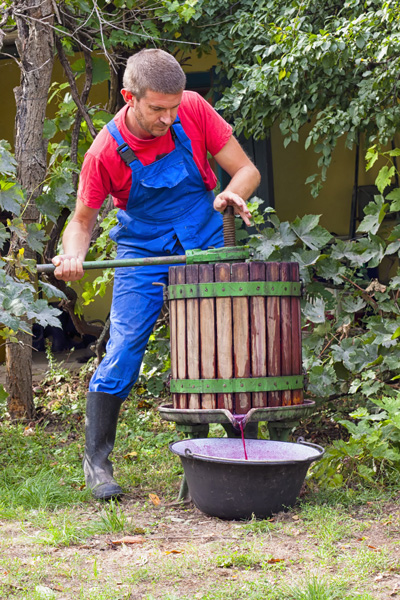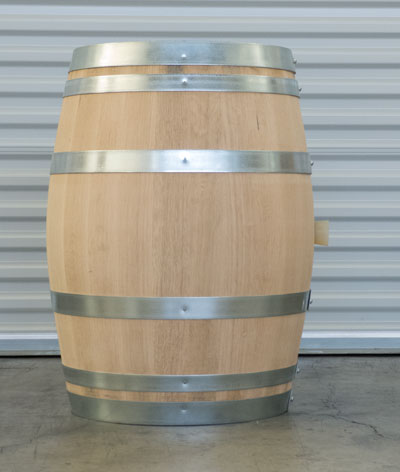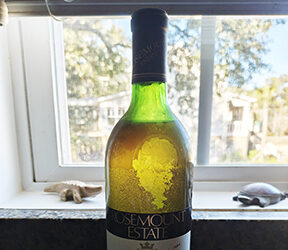Q
This past weekend I crushed and pressed two cases of Riesling grapes in my screw-type basket press and my yield of juice was not quite 4 gallons (15 L). The grape skins left in the basket after pressing seemed heavy with remaining juice despite my maximum effort at the press over an extended time. I’ve noticed that I get far more juice from my macerated red grapes (5+ gallons/19+ L per two cases) but maceration isn’t recommended for most white grapes per the references I use for my winemaking. Are there any solutions to improve juice yield when pressing white grapes? I’ve read about adding rice hulls to improve flow. It’s been suggested to me to (1) actually do a cold (40 °F/4 °C) maceration for a few days, (2) try freezing the grapes first, (3) buy a pneumatic press, or (4) give up on pressing white grapes and just buy juice. What would you suggest?
Jim Skufis
Ann Arbor, Michigan
A
You’ve hit on one of the classic difficulties of making wine at home. The equipment we use, from presses to barrels to filters, usually are much smaller than that used by commercial wineries. Yet the size of the grapes and the job we need our equipment to do remain the same. Getting a better press yield out of grapes, both red and white, is tough for home winemakers. The presses are smaller and, especially with hand-operated basket presses, there’s only so much force we can apply to the grapes. Your tale of wet, heavy grape skins tells me that indeed you did leave a lot of juice behind.

Fortunately, there are a few things that small-scale winemakers can do to improve juice yields. Think about using a maceration enzyme for white grapes. Enological enzymes are naturally occurring proteins that, when added at the crush stage and before pressing, can help break down the cells in the grape skin and pulp, which improves the press’s ability to release juice. Bottles of enzyme can be purchased from commercial winery labs like Scott Labs, Laffort USA, and AEB, but it might be better to try to source them through home winemaking supply businesses because chances are you’ll be able to buy them in smaller quantities. Products (and their concentrations) vary but it’s likely you’ll need less than 50 mL for the small-scale kind of winemaking you’re doing. Just be sure that the enzyme is fresh and has been stored properly. Age and exposure to UV light and high temperatures can all degrade an enzyme’s efficacy. Additionally, be sure to follow the manufacturer’s instructions exactly as too high of a dose can turn a batch of grapes into mush, an even more difficult prospect to press!
You’re absolutely correct that rice hulls, the papery outer shell that coats a grain of rice, can also be added in order to help increase juice yields. They work by helping to break up the gloppy “cake” of grapes in the press, providing miniature channels through which the juice can escape. I’ve used rice hulls in the past when pressing raspberries, and trust me, I used a lot of rice hulls! In your case with your press, I would layer handfuls of rice hulls into your basket press as you load it up with grapes. Luckily, rice hulls are inexpensive and can be found at most winemaking-homebrew supply stores (homebrewers commonly use rice hulls), well-stocked hardware stores, feed stores, and gardening centers (or online). If you don’t use all of the rice hulls, they can be stored for later use or they make great soil amendments for your compost pile or vegetable beds where they perform essentially the same function, providing air and friability for heavy or wet soils. Rice hulls work equally well for red (after fermentation is complete) or white (before fermentation) grapes as they are flavor-neutral and won’t leach anything harmful into your juice or wine.
You might also want to try using a press aid that you most likely were just throwing away: Grape stems. By destemming only a portion of your grapes (say 2⁄3 only) you’ll leave 1⁄3 of the grape clusters intact. When you load up your press (especially if you also use rice hulls) you’ll create plenty of internal juice channels through which your Riesling juice can escape. Just be careful of excess contact time with grape stems, as they are full of bitter, tannic compounds. If you have to leave your grapes in the press overnight for some reason, your juice risks picking up some of these compounds. If you plan to destem and press in one go, say over the course of a few hours, you should be fine. This is what winemakers mean when they use the terms “direct to press” or “whole cluster press” — you just dump the grapes in the press and go for it.
I don’t think I’d do a cold maceration on the grapes — again, you’d just be creating a lot of skin contact — and skin contact and white winemaking don’t really go well together. In my early winemaking career, I was working for a California winery, which shall remain nameless, in which the owner was a very, shall we say “adventurous” winemaker. He wanted us to take 12 tons of top-quality Riesling and do three days of skin contact before we pressed it, I think in a bid to get more of the “interesting” aromatics from the skin into the wine. The only interesting thing that resulted was that we ended up making 12 tons worth of light brown, tannic Riesling that we eventually had to sell for distillation material. In other words, I’m not a fan of white grapes and skin contact.
Freezing the grapes first is an interesting idea, and one that scientifically, at least, could make some sense. By freezing the grapes you’ll be breaking down the texture (cell structure) of the grapes. You’d also be increasing the skin contact time so you really need to assess if this is a character you want in your final wine. Furthermore, you’d have to have some serious freezer capacity to even attempt to do this. I think you’d get similar results by using a maceration enzyme and it’d be a lot easier to administer.
Don’t forget you can also add water to make up batch volume, but you do run the risk of diluting everything too much. Juice for winemaking needs to have the right mix of sugars, acids, yeast nutrients, and taste and aroma compounds. Too much water will throw that out of balance. If you press with all your might and still want to get some more volume, you could try supplementing the juice you do get with concentrate from a kit. There’s nothing wrong with reconstituting some frozen wine grape juice to help out your batch a little bit. Especially with an aromatic variety like Riesling, if you put in a little Chardonnay or even Thompson’s Seedless, it’s unlikely to detract from the character of the batch too much. Just make sure that you use a variety of concentrate that’s compatible with the wine you want to make. In your case, any neutral white grape concentrate should be fine. You can use concentrate to boost batch volume, color, or sugar when making red wines too. Cabernet Sauvignon concentrate is a great match for other big red Bordeaux wine grapes like Merlot, Cabernet Franc, or Malbec, or even your Syrah or Sangiovese type of grapes. I’d stick with a lighter “Gamay-type” red concentrate for lighter weight reds like Pinot Noir.
Q
During the stay-at-home period I enjoyed starting to bake bread, but yeast was tough to find in the grocery store. Can you use wine yeast for baking bread? Also is there a way to make a sourdough starter from the yeast found on grape skins and other fruits to give my bread a home winemaker’s twist?
Julie Stewart
Loveland, Ohio
A
You can definitely use wine yeast for baking bread. Bread yeast and wine yeast are both Saccharomyces cerevisiae and both work the same way, by eating sugar and converting it into ethanol and carbon dioxide gas. In the case of wine, the sugar comes from the grapes. In bread, the sugar (simple carbohydrates) can come from the flour, which often contains somewhere between 1–2% simple sugars, or from a small addition of granulated sugar. When flour is mixed with water, the simple sugars can be eaten by the yeast, leaving the starch to create the bread. It is, after all, the carbon dioxide produced by yeast that allows a loaf of bread to rise.
That said, wine yeast is a little different than bread yeast strains. Bread yeast strains aren’t bred (ha-ha) to be able to withstand high levels of alcohol so it’s not wise to try to make wine with bread yeast. Wine yeast will be able to operate just fine in the bread environment, which is not a high alcohol situation. Wine yeast is also, depending on the strain, a little slower to start than “rapid rise” bread yeast or yeast made specifically for bread machines. Think of bread yeasts as speedy sports cars and wine yeasts are family sedans. They’ve got slightly different performance stats, but both are automobiles that have four wheels, consume gas, and can get you where you want to go.
If I were to use old wine yeast (or even a fresh packet) for breadmaking, I’d be sure to hydrate it properly, i.e. 1 tbsp. yeast with about 1⁄3 cup hotter-than-warm water, or about 100–105 °F (38–41 °C). A proper “proofing” of the yeast, i.e. letting it get nice and bubbly for a few minutes after hydration, is important to make sure it’s not expired and is ready to use. Be sure to deduct this water from the amount in your recipe. It’s not advised to “pitch” dried wine yeast directly into flour or a bread machine; you’ll want to make sure it’s active and healthy before using in a recipe.
Indeed, you can even try to isolate yeast from your winemaking if you’d like to have a “winemaker’s sourdough starter.” During the harvest of 2019, I cultured my own starter using Pinot Noir grapes from my company’s Stanly Ranch in the Carneros AVA here in California. I was grape sampling with my son, and we saved about four fist-sized clusters from our sampling buckets. I made a flour-water slurry with about ½ cup all-purpose flour and about ¾ cup filtered water in a large bowl. Then, I lightly squished the grape clusters over the bowl with my hands, allowing the juice to run into the bowl. I deposited all four of the squished grape clusters, stems and all, into the slurry and mixed it all around. We covered the bowl with a clean dishtowel and then set the bowl on the picnic table in the shade (about 78 °F/26 °C) for the day. That evening, I fished out the grape stems, being sure to leave the grape berries in the bowl, and stirred in another ¼ cup water and ¼ cup flour before covering the bowl, leaving it on the kitchen counter and going to bed.
Wine yeast is also, depending on the strain, a little slower to start than “rapid rise” bread yeast or yeast made specifically for bread machines.
The next morning, I noticed that my purple-and-white (no, it’s not an attractive process) slurry was a little bubbly and had started to smell slightly like wine. I fed in another ¼ cup flour and ¼ cup filtered water, stirred it, covered it, and left it in my oven on the “proof” heat setting all day. By that evening, I noticed it had started to get quite bubbly and between the natural yeast on the grapes and the sugar in the grape juice, I had a fermentation on my hands! It was then that I used a rough mesh strainer to get out all of the seeds and skins (passing though a colander would work too) out of my flour-grape slurry. I added another ¼ cup flour and ¼ cup water, stirred and went to bed. The next morning, I fed it again (by this time it was starting to grow quite a bit in the bowl), set it in the oven on “proof” again and checked to see how active it was in a few hours. By now there were definite bubbles of gas being created and it was quite active. I reserved 1 cup of this in a clean glass jar, covered it with a paper towel and stored him in the refrigerator . . . and that became “Stanly the Sourdough Starter,” whom I’ve since shared with friends and neighbors here in my hometown.
There are so many sources online to learn about how to use and maintain a sourdough starter, especially now that the entire country seems to be into baking bread. I don’t have the space in this column to go into bread baking master class, but my one piece of advice would be to “think like a winemaker.” You know yeast like food and the correct temperatures in which to grow, and that winemaking takes patience. So it is with sourdough baking. You’ve got a big leg up since you’ve already got “microbial smarts” when it comes to managing a yeast culture.
Q
I’ve been a home/ hobby winemaker for some years but last year I took a big leap with three new demijohns. The increase in volume caused me to move my aging wines to a part of the cellar where there is a small south-facing window. While the carboys and demijohns are in a drop-cloth tent, and there is a piece of paper covering the window, indirect sunlight still comes through. Question, can this indirect light affect the aging of the wine? In particular, any impact on the color profile? Instead of a deep red/purple color, it is bright but a lighter ruby shade. Any thoughts or concerns?
Michael Beudry
Newtown, Connecticut
A
I would definitely try to store your wine in the dark if you can. Your wines are in what I’m assuming are clear glass demijohns and over the year or more aging you might want for the wine, it could be enough to be detrimental to your wine’s quality.
Interestingly, it’s not damage to your wine’s color that I would worry about the most; it’s damage to the wine’s aromas and flavors. Clear glass blocks so little UV light that it essentially offers no protection at all. Though indeed high UV light exposure could contribute to premature oxidation of pigments, light can interact with amino acids and other sulfur-containing compounds naturally occurring in wine, resulting in dimethyl disulfide (DMDS) or other aromatic sulfides. These compounds are super stinky; think overcooked cabbage, wet cardboard, or rotten onions. Not aromas you’d really want to have in something you’ve invested so much of your time and effort.
This defect is sometimes called “light strike” and is the reason that dark green or dark brown bottles are so traditional as wine bottle colors. Ever heard of “skunky” beer? Beer and cider can also be victims of light strike when UV light cleaves off sulfur-containing molecules, rearranging them into stinky new compounds. For this reason, white wines (and rosés) that are meant to be consumed quickly without aging are typically the only wines bottled in clear (sometimes called “flint”) glass bottles. It’s also why wines are aged best in barrels, metal kegs, or stainless tanks. Glass carboys can be fine for temporary wine storage, but it’s always best to keep them in a room where you can turn off the lights when you’re not working with the wine.







